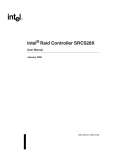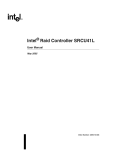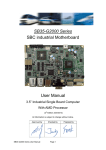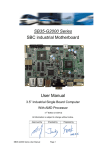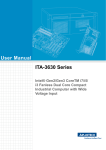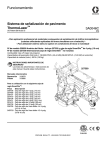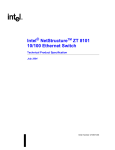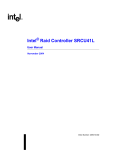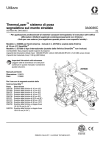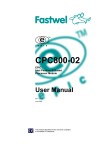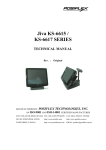Download PDF
Transcript
Intel® 852GM Small Form Factor Proof-of-Concept Board User’s Manual March 2006 Order Number: 309239-002 INFORMATION IN THIS DOCUMENT IS PROVIDED IN CONNECTION WITH INTEL® PRODUCTS. EXCEPT AS PROVIDED IN INTEL’S TERMS AND CONDITIONS OF SALE FOR SUCH PRODUCTS, INTEL ASSUMES NO LIABILITY WHATSOEVER, AND INTEL DISCLAIMS ANY EXPRESS OR IMPLIED WARRANTY RELATING TO SALE AND/OR USE OF INTEL PRODUCTS, INCLUDING LIABILITY OR WARRANTIES RELATING TO FITNESS FOR A PARTICULAR PURPOSE, MERCHANTABILITY, OR INFRINGEMENT OF ANY PATENT, COPYRIGHT, OR OTHER INTELLECTUAL PROPERTY RIGHT. Intel Corporation may have patents or pending patent applications, trademarks, copyrights, or other intellectual property rights that relate to the presented subject matter. The furnishing of documents and other materials and information does not provide any license, express or implied, by estoppel or otherwise, to any such patents, trademarks, copyrights, or other intellectual property rights. Intel products are not intended for use in medical, life saving, life sustaining, critical control or safety systems, or in nuclear facility applications. Intel may make changes to specifications and product descriptions at any time, without notice. Designers must not rely on the absence or characteristics of any features or instructions marked “reserved” or “undefined.” Intel reserves these for future definition and shall have no responsibility whatsoever for conflicts or incompatibilities arising from future changes to them. The Intel® 852GM Small Form Factor Proof-of-Concept Board may contain design defects or errors known as errata which may cause the product to deviate from published specifications. Current characterized errata are available on request. MPEG is an international standard for video compression/decompression promoted by ISO. Implementations of MPEG CODECs, or MPEG enabled platforms may require licenses from various entities, including Intel Corporation. This User’s Manual as well as the software described in it is furnished under license and may only be used or copied in accordance with the terms of the license. The information in this manual is furnished for informational use only, is subject to change without notice, and should not be construed as a commitment by Intel Corporation. Intel Corporation assumes no responsibility or liability for any errors or inaccuracies that may appear in this document or any software that may be provided in association with this document. Except as permitted by such license, no part of this document may be reproduced, stored in a retrieval system, or transmitted in any form or by any means without the express written consent of Intel Corporation. Contact your local Intel sales office or your distributor to obtain the latest specifications and before placing your product order. Copies of documents which have an ordering number and are referenced in this document, or other Intel literature may be obtained by calling 1-800-548-4725 or by visiting Intel's website at http://www.intel.com. AnyPoint, AppChoice, BoardWatch, BunnyPeople, CablePort, Celeron, Chips, CT Media, Dialogic, DM3, EtherExpress, ETOX, FlashFile, i386, i486, i960, iCOMP, InstantIP, Intel, Intel Centrino, Intel logo, Intel386, Intel486, Intel740, IntelDX2, IntelDX4, IntelSX2, Intel Create & Share, Intel GigaBlade, Intel InBusiness, Intel Inside, Intel Inside logo, Intel NetBurst, Intel NetMerge, Intel NetStructure, Intel Play, Intel Play logo, Intel SingleDriver, Intel SpeedStep, Intel StrataFlash, Intel TeamStation, Intel Xeon, Intel XScale, IPLink, Itanium, MCS, MMX, MMX logo, Optimizer logo, OverDrive, Paragon, PC Dads, PC Parents, PDCharm, Pentium, Pentium II Xeon, Pentium III Xeon, Performance at Your Command, RemoteExpress, SmartDie, Solutions960, Sound Mark, StorageExpress, The Computer Inside., The Journey Inside, TokenExpress, VoiceBrick, VTune, and Xircom are trademarks or registered trademarks of Intel Corporation or its subsidiaries in the United States and other countries. *Other names and brands may be claimed as the property of others. Copyright © 2006, Intel Corporation 2 Intel® 852GM Small Form Factor Proof-of-Concept Board User’s Manual Contents Contents 1 Product Overview ............................................................................................................................ 6 1.1 1.2 1.3 1.4 1.5 2 Introduction ........................................................................................................................... 6 Related Documents .............................................................................................................. 6 Product Contents .................................................................................................................. 7 Proof-of-Concept Board Features......................................................................................... 7 SFF POC Board Block Diagram ........................................................................................... 9 Installation Guide for POC Board .................................................................................................. 11 2.1 2.2 3 Before You Begin................................................................................................................ 11 Setting up the SFF POC Board ..........................................................................................11 Connectors and Jumpers .............................................................................................................. 15 3.1 3.2 List of Jumpers ................................................................................................................... 16 List of Connectors ...............................................................................................................18 Figures 1 2 3 4 5 6 SFF POC Board Block Diagram ...................................................................................................9 SFF Placement - Top View......................................................................................................... 10 Assembled Board, Front View .................................................................................................... 12 20-pin Power Supply Connector .................................................................................................14 SFF POC Board Connectors and Jumpers ................................................................................ 15 SFF POC Board Solder Side ...................................................................................................... 16 Tables 1 2 3 4 6 7 8 9 5 10 11 12 13 14 15 16 17 18 19 Related Documents ......................................................................................................................6 Additional Hardware ................................................................................................................... 11 Jumper Settings.......................................................................................................................... 12 Jumpers ...................................................................................................................................... 16 LCD Voltage Selection (JP2) ...................................................................................................... 17 COM2 RS-232/422/485 Selection (JP3) .....................................................................................17 COM2 RS-232/422/485 Selection (JP4) .....................................................................................17 RI/+5V/+12V Selection (JP5)...................................................................................................... 17 Clear CMOS (JP1) ......................................................................................................................17 Connectors ................................................................................................................................. 18 USB Connector (CN1) ................................................................................................................ 18 USB Connector (CN2) ................................................................................................................ 19 Primary IDE Hard Drive Connector (CN3) .................................................................................. 19 Digital IO Connector (CN4)......................................................................................................... 20 Front Panel (CN5)....................................................................................................................... 20 Serial Port COM2 Connector (CN6) RS-232 Mode .................................................................... 20 Serial Port COM2 Connector (CN6) RS-422 Mode .................................................................... 20 Serial Port COM2 Connector (CN6) RS-485 Mode .................................................................... 21 Parallel Port Connector (CN7) .................................................................................................... 21 Intel® 852GM Small Form Factor Proof-of-Concept Board User’s Manual 3 Contents 20 21 22 23 24 25 26 27 28 29 30 31 32 33 4 Dual Channel LVDS Connector (CN8) ....................................................................................... 21 4P Power Connector (CN9) ........................................................................................................ 22 TV-out Connector (CN10)........................................................................................................... 22 DVI Connector (CN11) ............................................................................................................... 22 Audio Input/Output Connector (CN12) ....................................................................................... 23 Ethernet 10/100BaseT RJ-45 Phone Jack Connector (CN13) ................................................... 23 External 5VSB/PWRGD Connector (CN14) ............................................................................... 23 IrDA Connector (CN15) .............................................................................................................. 23 Fan Connector (CN16) ............................................................................................................... 24 Mini-DIN PS/2 Connector (CN17)............................................................................................... 24 Serial Port COM1 Connector (CN18) ......................................................................................... 24 CRT Display Connector (CN19) ................................................................................................. 25 External Battery (VBA T2) .......................................................................................................... 25 Compact Flash Disk Slot (CFD) ................................................................................................. 25 Intel® 852GM Small Form Factor Proof-of-Concept Board User’s Manual Contents Revision History Date Revision Description March 2006 002 Updated with branding changes. September 2005 001 Initial release Intel® 852GM Small Form Factor Proof-of-Concept Board User’s Manual 5 Product Overview 1 Product Overview 1.1 Introduction The POC board utilizes the Ultra Low Voltage Intel® Celeron® M or Mobile Intel® Celeron® processor, Intel® 852GM chipset and the Intel® FW82801DB I/O Controller Hub. It is a fanless design which provides higher processing capability with excellent power consumption control. It offers a stable and efficient solution for customer who is seeking a trade-off between high performance and low power consumption. The POC board supports multiple display modes including CRT, LCD, DVI and TV-out. With the dimension of 146 mm X 102 mm, SFF also has the expansion capability through on-board Mini-PCI slot. 1.2 Related Documents For more information, please contact your Intel local representative. Table 1. Related Documents Intel Order Number 6 Document Location 251308 Mobile Intel® Celeron® Processor Datasheet www.intel.com/design/mobile/ datashts/251308.htm 300302 Intel® Celeron® M Processor Datasheet www.intel.com/design/mobile/ datashts/300302.htm 252407 Intel® 852GM Chipset (GMCH) Datasheet www.intel.com/design/mobile/ datashts/252407.htm 290744 Intel® 82801DB I/O Controller Hub 4 (ICH4) Datasheet www.intel.com/design/chipsets/ datashts/290744.htm 290745 Intel® 82801DB I/O Controller Hub 4 (ICH4) Specification Update http://developer.intel.com/ design/chipsets/specupdt/ 290745.htm 252338 Intel® 852GM Chipset Platform Design Guide www.intel.com/design/mobile/ desguide/252338.htm Intel® 852GM Small Form Factor Proof-of-Concept Board User’s Manual Product Overview 1.3 Product Contents The SFF POC board is shipped with the following peripherals and features: • • • • • • • • • • 1.4 One SFF POC Board with heat sink One IDE cable One Keyboard/Mouse cable Two USB cables One Audio cable One COM port cable One TV-out and S-terminal cable One DVI cable One Parallel port cable One Jumper cap Proof-of-Concept Board Features The proof-of-concept board features are summarized as below: System: • CPU: Onboard Intel® Celeron® M Processor Ultra Low Voltage 600 MHz 512K L2 Cache or Mobile Intel Celeron Processor at 600MHz Processor • • • • • • • • • • • • • Memory: 200-pin DDR 266MHz SODIMM x 1, Max. 1GB Chipset: Intel 852GM chipset + Intel® 82801DB I/O Controller Hub 4 (ICH4) I/O Chipset: ITE IT8712F Ethernet: Intel® 82562 Fast Ethernet Controller, 10/100Base-TX RJ-45 BIOS: AWARD 512KB FLASH ROM Watchdog Timer: Generate a Time-out System Reset SSD: Type II CompactFlash* slot x 1 Expansion Interface: Type III Mini PCI Socket x 1 Battery: Lithium battery Power Supply Voltage: +5V. AT/ATX Board Size: 5.75”(L) x 4”(W) (146mm x 102mm) Gross Weight: 0.55lb(0.4kg) Operating Temperature: 32ºF~140ºF (0ºC~60ºC) Intel® 852GM Small Form Factor Proof-of-Concept Board User’s Manual 7 Product Overview Display: • Chip: Intel 852GM chipset + Chrontel 7009 • Memory: Shared System Memory Up to 64 MB with DVMT • Resolutions: Up to 1280 x 1024 @ 32bpp Colors for CRT and Up to 1280 x 1024 @ 24 bpp Colors for LCD • TV-Out: Supports NTSC and PAL standard; I/O: • Miscellaneous: EIDE x 1(UDMA33 x 1), KB + Mouse x 1, RS-232 x 1, RS-232/422/485 x 1, Parallel x 1 • IrDA: IrDA Tx/Rx Header x 1 • Audio: MIC in, Line in, Line out 5.1 Output • USB: Two 5 x 2 Pin Headers Support 4 USB 2.0 Ports 8 Intel® 852GM Small Form Factor Proof-of-Concept Board User’s Manual Product Overview 1.5 SFF POC Board Block Diagram Figure 1. SFF POC Board Block Diagram mFCBGA Intel® Celeron® M processor Intel® 82852GM/GME Graphics Controller 400MHz FSB Clock Synthesizer DDR266 Intel® 82801DB I/O Controller Hub 4 (ICH4) Intel® 82562ET Fast Ethernet Controller Intel® 852GM Small Form Factor Proof-of-Concept Board User’s Manual 9 Product Overview Figure 2. SFF Placement - Top View Intel® 82801DB I/O Controller Hub 4 (ICH4) Intel® 852GM chipset For more details information on connectors’ placement, please refer to Chapter 3, “Connectors and Jumpers”. 10 Intel® 852GM Small Form Factor Proof-of-Concept Board User’s Manual Installation Guide for POC Board Installation Guide for POC Board 2.1 2 Before You Begin Table 2 represents the additional hardware you may require to set up the board. Table 2. Additional Hardware Component 2.2 Description VGA Monitor Standard VGA or greater resolution monitor Keyboard Keyboard with a PS/2 connector or adapter Mouse Mouse with a PS/2 connector or adapter IDE Devices Up to two IDE devices can be connected to the POC board. One cable is included in this kit. The cable accommodates the included hard drive and one other IDE device, such as a CD-ROM drive or another hard drive. Network Adapter An Intel® 82562ET Ethernet Controller is included in the development kit. A CAT-5 cable with an RJ-45 connector is required to connect this Ethernet adapter to local area network. AT Power Supply Require an AT power supply to power the board. If you are using ATX power supply, some minor work is required. Memory Require one module of 200-pin DDR266 SODIMM (max 1 GB) Other Devices and Adapters Many PC compatible peripherals can be attached and configured to work with the POC board. For example, to install an additional network adapter into the mini PCI slot. Procuring and installing any drivers required for additional devices will need to be done by user. Setting up the SFF POC Board Gather the hardware described in Table 2 and follow the steps below to set up the POC board. This manual assumes you are familiar with basic concepts of installing and configuring hardware for an x86 architecture platform. 1. Ensure a static-free work environment. Static-free procedures must be completed before removing any components from various anti-static packaging. The POC board is susceptible to electrostatic discharge (ESD), which may cause product failure or unpredictable operation. Warning: Connecting the wrong cable or reversing a cable may damage the POC board and the device being connected. Since the board is not in a protective chassis, use caution when connecting cables to this product. 2. Verify contents. Inspect the contents of your kit and make sure that everything listed in Section 2.1 is included. Check for damage that may have occurred during shipment. 3. Check jumper settings. Verify that the following jumpers are set in their default state (see Table 3). Intel® 852GM Small Form Factor Proof-of-Concept Board User’s Manual 11 Installation Guide for POC Board Table 3. Jumper Settings Jumper Function Default Setting J1 Clear CMOS 1-2 Normal J2 LCD Voltage Selection 1-2 +5 V J3 COM2 RS-232/422/485 Mode Selection - 1 1-2 RS232 J4 COM2 RS-232/422/485 Mode Selection - 1 1-2 RS232 J5 COM2 RI/+5V/+12V Selection 5-6 RI 4. Verify installed hardware. Make sure the following hardware is populated on your POC board: • • • • Note: One Onboard Intel® Celeron® M processor 1.3 GHz, mFCBGA479 package BIOS FWH Battery Heatsink If the above hardware is not installed correctly, DO NOT apply power to the board. Correctly re-install the components before proceeding. 5. Install memory. Install the SO-DIMM in memory slot DIMM1. Insert the SO-DIMM above the slot (the DIMM is keyed so that it only fits in the slot in one orientation). Firmly, but carefully, insert the SO-DIMM into the slot until the tabs close. Figure 3. 12 Assembled Board, Front View Intel® 852GM Small Form Factor Proof-of-Concept Board User’s Manual Installation Guide for POC Board 6. Install storage devices. There is one IDE connector on the POC board that supports two IDE devices—a master and a slave. Attach the unconnected pin 41-43 header to the board. For a correct boot-up of the system, the included hard drive must be installed as the primary master. Note: Master/slave settings are determined by a jumper on each IDE device. Consult the device label/ documentation to verify that the jumper is set correctly for your configuration. 7. A CD-ROM drive or additional hard drive may be installed as a primary slave device. To install the included hard drive on the POC board: a. Verify that the jumper on the hard drive is set correctly for single or master, depending on your configuration. b. Connect the end of the IDE cable (pin 41-43) to the IDE connector CN3 on the board. Ensure that the tracer on the cable is aligned with pin 1 of the connector. c. Connect the middle connector of the cable to the hard drive. Again, ensure that the cable tracer is aligned with pin 1 of the connector. Warning: Failure to properly align the IDE cable may damage the POC board and/or the hard drive. d. Connect the four-pin power connector from the power supply to the hard drive. 8. Install the CD-ROM drive (optional). A CD-ROM drive is not included in the kit and is not required, but it may be useful in loading additional software. To install it on the POC board: a. Verify that the jumper on the CD-ROM drive is set for slave. b. Connect the unused end of the IDE cable you already attached to the POC board to the CDROM drive. Ensure that the cable tracer is aligned with pin 1 of the CD-ROM drive connector. c. Connect a large four-pin power connector from the power supply to the CD-ROM drive. 9. Connect the monitor. Connect the monitor cable to the VGA port. 10. Connect the keyboard and mouse. Connect the KB/Mouse cable to the Mini-Din PS/2 connector CN17 on the POC board. Then connect a PS/2 mouse and keyboard to the KB/ Mouse cable. Alternatively, USB keyboard and a USB mouse maybe plug into one or both of the USB connectors on the POC board. Note that a legacy (PS/2) keyboard may be required for BIOS setup. Note: Prior to connect the USB keyboard and USB mouse, you must first have the USB cable connect to the connector CN1 or CN2 on the POC board. 11. Connect the power supply. Make sure the power supply is turned off and unplugged. Connect the AT 4P power supply cables to connector CN9 on the POC board. Next, plug the power cord into the power supply and the wall. 12. Power up the system. Turn on the monitor and follow by the power supply. If you are using the ATX power supply, then you will need to short the pin15 (black) and pin14 (green) of the 20pin power supply connector in order to power up the system. Warning: Loose jumper wire could lead to intermittent power which could eventually damage the POC board or cause electrical short to the user. Intel® 852GM Small Form Factor Proof-of-Concept Board User’s Manual 13 Installation Guide for POC Board Figure 4. 20-pin Power Supply Connector Warning: Powering up without all components installed correctly can lead to a failure that can damage the board. Do not apply power to the board until any loose components are fixed. §§ 14 Intel® 852GM Small Form Factor Proof-of-Concept Board User’s Manual Connectors and Jumpers 3 Connectors and Jumpers This section describes the placement of the connectors as well as setting jumpers setting on the board. Figure 5. SFF POC Board Connectors and Jumpers CN9 C N 14 C N 19 C N 17 C N 16 CN8 C N 18 C N 11 12 11 7 8 C N 10 9 10 JP 2 1 2 C N 13 C N 15 M PC I1 C N 12 JP5 JP4 CN 7 JP 3 CN6 CN5 C N4 CN 3 CN2 CN1 JP1 Intel® 852GM Small Form Factor Proof-of-Concept Board User’s Manual 15 Connectors and Jumpers Figure 6. SFF POC Board Solder Side CFD1 DIMM1 3.1 List of Jumpers Table 4 must be used in setting the jumpers on the POC board. These tables give details about the jumpers shown in Figure 5and Figure 6. The jumpers allow configuring the system to user’s application. The table below shows the function of each of the board’s jumpers: Table 4. 16 Jumpers Label Function JP1 Clear CMOS JP2 LCD Voltage Selection JP3 COM2 RS-232/422/485 Mode Selection – 1 JP4 COM2 RS-232/422/485 Mode Selection – 2 JP5 COM2 RI /+5 V /+12 V Selection Intel® 852GM Small Form Factor Proof-of-Concept Board User’s Manual Connectors and Jumpers Table 5. Table 6. Clear CMOS (JP1) JP1 Function 1-2 Normal (Default) 2-3 Clear CMOS LCD Voltage Selection (JP2) JP2 Table 7. Table 8. Table 9. Function 1-2 +5 V 2-3 +3.3 V (Default) COM2 RS-232/422/485 Selection (JP3) JP3 Function 1-2, 4-5, 7-8, 10-11 RS-232 (Default) 2-3, 5-6, 8-9, 11-12 RS-422 2-3, 8-9 RS-485 COM2 RS-232/422/485 Selection (JP4) JP4 Function 1-2 RS-232(Default) 3-4 RS-422 5-6 RS-485 RI/+5V/+12V Selection (JP5) JP5 Function 5-6 RI(Default) 3-4 +5 V 1-2 +12 V Intel® 852GM Small Form Factor Proof-of-Concept Board User’s Manual 17 Connectors and Jumpers 3.2 List of Connectors The POC board has a number of connectors configuring the system to user’s application. The table below shows the function of each board’s connectors: Table 10. Connectors Label Table 11. 18 Function CN1 USB 2.0 Port 1 Connector CN2 USB 2.0 Port 2 Connector CN3 Primary IDE Hard Drive Connector CN4 Digital I/O Connector CN5 Front Panel CN6 Serial Port COM2 Connector CN7 Parallel Port 1 Connector CN8 Dual Channel LVDS Connector CN9 4P Power Connector CN10 TV-Out Connector CN11 DVI Connector CN12 Audio Input/Output Connector CN13 Ethernet 10/100BaseT RJ-45 Phone Jack CN14 External 5VSB/PWRGD Connector CN15 IrDA Connector CN16 Fan Connector CN17 Mini-Din PS/2 Connector CN18 Serial Port COM1 Connector CN19 CRT Display Connector MPCI1 Mini-PCI Slot CFD1 CompactFlash* Disk Slot USB Connector (CN1) Pi n Si gn al Pin Sig na l 1 USBVDD0-1 2 GND 3 USBD0- 4 GND 5 USBD0+ 6 UDBD1+ 7 GND 8 USBD1- 9 GND 10 USBVDD0-1 Intel® 852GM Small Form Factor Proof-of-Concept Board User’s Manual Connectors and Jumpers Table 12. Table 13. USB Connector (CN2) P in S ign a l Pin Si gn al 1 USBVDD2-3 2 GND 3 USBD2- 4 GND 5 USBD2+ 6 UDBD3+ 7 GND 8 USBD3- 9 GND 10 USBVDD2-3 Primary IDE Hard Drive Connector (CN3) P in Sig na l Pin S ign a l 1 PRI_IDERST# 2 GND 3 PDD7 4 PDD8 5 PDD6 6 PDD9 7 PDD5 8 PDD10 9 PDD4 10 PDD11 11 PDD3 12 PDD12 13 PDD2 14 PDD13 15 PDD1 16 PDD14 17 PDD0 18 PDD15 19 GND 20 N.C. 21 PDREQ 22 GND 23 PDIOW# 24 GND 25 PDIOR# 26 GND 27 PIORDY 28 GND 29 PDDACK# 30 GND 31 IRQ14 32 N.C. 33 PDA1 34 P66DET 35 PDA0 36 PDA2 37 PDCS#1 38 PDCS#3 39 IDEACTP# 40 GND 41 +5V 42 +5V 43 GND 44 N.C. Intel® 852GM Small Form Factor Proof-of-Concept Board User’s Manual 19 Connectors and Jumpers Table 14. Table 15. Table 16. Table 17. 20 Digital IO Connector (CN4) Pin Signal Pin Signal 1 DIN_IN0 2 DIN_IN1 3 DIN_IN2 4 DIN_IN3 5 DIO_OUT0 6 DIO_OUT1 7 DIO_OUT2 8 DIO_OUT3 9 +5V 10 GND Front Panel (CN5) Pin Signal 1-2 ATX Power-On Button 3-4 HDD Active LED 5-6 External Speaker 7-8 Power LED 9-10 System Reset Button Serial Port COM2 Connector (CN6) RS-232 Mode Pin Signal Pin Signal 1 DCDB 2 RXB 3 TXB 4 DTRB 5 GND 6 DSRB 7 RTSB 8 CTSB 9 RIB 10 N. C. Serial Port COM2 Connector (CN6) RS-422 Mode Pin Signal Pin Signal 1 TXD- 2 RXD+ 3 TXD+ 4 RXD- 5 N. C. 6 N. C. 7 N. C. 8 N. C. 9 GND 10 N. C. Intel® 852GM Small Form Factor Proof-of-Concept Board User’s Manual Connectors and Jumpers Table 18. Table 19. Table 20. Serial Port COM2 Connector (CN6) RS-485 Mode P in S ign a l Pin Si gn al 1 TXD- 2 N.C. 3 TXD+ 4 N. C. 5 N. C. 6 N. C. 7 N. C. 8 N. C. 9 GND 10 N. C. Parallel Port Connector (CN7) P in Sig na l Pin S ign a l 1 STBX 2 AFD# 3 PTD0 4 ERR# 5 PTD1 6 PINIT# 7 PTD2 8 SLIN# 9 PTD3 10 GND 11 PTD4 12 GND 13 PTD5 14 GND 15 PTD6 16 GND 17 PTD7 18 GND 19 ACK# 20 GND 21 BUSY 21 GND 23 PE 23 GND 25 SLCT 26 N. C. Dual Channel LVDS Connector (CN8) (Sheet 1 of 2) P in S ig na l Pi n Si gn al 1 Back-Light Enable 2 Back-Light Control 3 LCD Volt. 4 GND 5 TXLCLK# 6 TXLCLK 7 LCD Volts 8 GND 9 TXL0# 10 TXL0 11 TXL1# 12 TXL1 13 TXL2# 14 TXL2 15 TXL3# 16 TXL3 17 LVDS_DATA 18 LVDS_CLK Intel® 852GM Small Form Factor Proof-of-Concept Board User’s Manual 21 Connectors and Jumpers Table 20. Table 21. Table 22. Table 23. 22 Dual Channel LVDS Connector (CN8) (Sheet 2 of 2) 19 TXU0# 20 TXU0 21 TXU1# 22 TXU1 23 TXU2# 24 TXU2 25 TXU3# 26 TXU3 27 LCD Volt. 28 GND 29 TXUCLK# 30 TXUCLK 4P Power Connector (CN9) Pi n Si gna l 1 +5 V 2 GND 3 GND 4 +12 V TV-out Connector (CN10) Pi n Si gn al Pin Sig na l 1 Y 2 CVBS 3 GND 4 GND 5 C 6 N. C. 7 GND 8 N. C. DVI Connector (CN11) Pi n Si gn al Pin S ig na l 1 TD1 2 TD1# 3 GND 4 GND 5 TDC 6 TDC# 7 GND 8 +5 V 9 HPDET 10 +5 V 11 TD2 12 TD2# 13 GND 14 GND 15 TD0 16 TD0# 17 N.C. 18 N.C. 19 DVI_DATA 20 DVI_CLK Intel® 852GM Small Form Factor Proof-of-Concept Board User’s Manual Connectors and Jumpers Table 24. Table 25. Table 26. Audio Input/Output Connector (CN12) P in Sig na l Pi n S ign a l 1 MIC_IN 2 MIC_Vcc 3 Audio GND 4 CD_GND 5 LINE_IN L 6 CD_L 7 LINE_IN R 8 CD_GND 9 Audio GND 10 CD_R 11 LINE_OUT L 12 LINE_OUT R 13 Audio GND 14 Audio GND Ethernet 10/100BaseT RJ-45 Phone Jack Connector (CN13) P in Sig na l Pi n S ign a l 1 TX+ 2 TX- 3 TCT 4 N.C. 5 N.C. 6 RCT 7 RX+ 8 RX- 9 LINK_LED 10 ACT_LED 11 SPD_LED 12 +3.3V External 5VSB/PWRGD Connector (CN14) Pi n Table 27. Sig na l 1 N. C. 2 GND 3 N, C, 4 GND 5 PS_ON 6 +5 V (Standby) IrDA Connector (CN15) Pi n Sig na l 1 +5 V 2 N. C. (CIR_Tx_Option) 3 Rx Intel® 852GM Small Form Factor Proof-of-Concept Board User’s Manual 23 Connectors and Jumpers Table 27. Table 28. IrDA Connector (CN15) 4 GND 5 Tx 6 N. C. (CIR_Tx_Option) Fan Connector (CN16) Pin Table 29. Table 30. 24 S ig na l 1 Fan Sense 2 +5 V 3 GND Mini-DIN PS/2 Connector (CN17) Pi n Si gn al Pin S ig na l 1 Keyboard Data 2 Mouse Data 3 GND 4 Shield 5 +5 V 6 Keyboard Clock 7 Shield 8 Mouse Clock Serial Port COM1 Connector (CN18) Pi n Si gn al P in S ign a l 1 DCDA 2 RXA 3 TXA 4 DTRA 5 GND 6 DSRA 7 RSTA 8 CTSA 9 RIA 10 N. C. Intel® 852GM Small Form Factor Proof-of-Concept Board User’s Manual Connectors and Jumpers Table 31. Table 32. CRT Display Connector (CN19) P in S ig na l Pi n Sig na l 1 CRT_RED 9 5V 2 CRT_GREEN 10 VGA GND 3 CRT_BLUE 11 N.C. 4 N.C. 12 CRT_SDA 5 VGA GND 13 CRT_HSYNC 6 VGA GND 14 CRT_VSYNC 7 VGA GND 15 CRT_SCL 8 VGA GND External Battery (VBA T2) Pi n Table 33. Sig na l 1 VBAT (+3.3 V) 2 GND Compact Flash Disk Slot (CFD) (Sheet 1 of 2) P in S ig na l Pi n Sig na l 1 GND 26 GND 2 SDD3 27 SDD11 3 SDD4 28 SDD12 4 SDD5 29 SDD13 5 SDD6 30 SDD14 6 SDD7 31 SDD15 7 SDCS#1 32 SDCS#3 8 GND 33 GND 9 GND 34 SDIOR# 10 GND 35 SDIOW# 11 GND 36 +5 V 12 GND 37 IRQ15 13 +5 V 38 +5V 14 GND 39 CSEL# 15 GND 40 N.C. 16 GND 41 IDERST# 17 GND 42 SIORDY Intel® 852GM Small Form Factor Proof-of-Concept Board User’s Manual 25 Connectors and Jumpers Table 33. 26 Compact Flash Disk Slot (CFD) (Sheet 2 of 2) Pi n Si gn al Pin S ig na l 18 SDA2 43 DMAREQ 19 SDA1 44 DMAACK 20 SDA0 45 DASP# 21 SDD0 46 PDIAG# 22 SDD1 47 SDD8 23 SDD2 48 SDD9 24 N.C. 49 SDD10 25 GND 50 GND Intel® 852GM Small Form Factor Proof-of-Concept Board User’s Manual



























